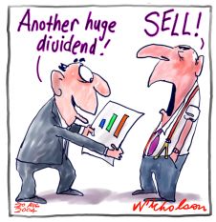Many mergers fall flat on their faces and many become legendary. Mergers and acquisitions can cause bankruptcy, the firing of executives and even a breakup. On the other hand they have the potential to generate growth, increased market power, cross-border advantages, synergy etc. We tend to think of a merger and an acquisition/takeover as the same was when in fact they are somewhat dissimilar. A merger is the combining of assets and operations, usually between two similar sized companies, in an agreement to join together. In contrast, a takeover is the procurement of one company by another through the purchases of share capital. Most mergers/takeovers have a certain degree of risk attached to it but through accurate planning, knowledge and intuition they can be extremely successful. For the purposes of investigating what causes a successful and a not so successful merger/takeover I am going to analyze and contrast two high profile takeovers, Disney-Pixar and Quaker-Snapple.
Walt Disney took over Pixar for a whopping $7.8 Billion in 2006. “Most acquisitions, particularly in media, are value-destroying as opposed to value-creating, and that certainly has not turned out to be the case here,”, a quote from David A. Prices 2008 book ‘The Pixar Touch: The Making of a Company’ This quotation encapsulates what happened with this acquisition. It wasn’t until the run up to the end of the production contract between the two companies when Disney decided they didn’t want to lose connection with Pixar and it was obvious that a merger made perfect sense. Since the acquisition Disney-Pixar has pumped out movies such as ‘WALL-E’, ‘Up’ and ‘Bolt’ with plans for Pixar to release movies twice-yearly, unimaginable before the takeover.
One of the key reasons for the success enjoyed by Disney-Pixar is due to how related the business where before the takeover which leads to more synergies when merged. The joining boosted Pixar’s creativity leading to higher quality cinematic output than before. Disney opened the door to a huge distribution network for Pixar’s releases. Gordon Phillips, Bank of America professor at the University of Maryland and a research associate at the National Bureau of Economic Research (NBER), views that:
“The Disney-Pixar merger is consistent with Disney choosing Pixar because it is similar enough to permit new product synergies,”,
“Following the merger, many Disney computer-animated movies (e.g., Toy Story, A Bug’s Life, Cars) have been produced using Pixar technology and distributed by the merged company.”,
Gordon Phillips
I believe this friendly takeover allowed both companies to avoid future competition and increased market power. Two of the major players in the creation and production of animated movies industry joining forces would seem like a key play to any competitor or onlooker. The premium that Disney paid for the Pixar acquisition was without a doubt evaluated in light of the nature of the animation content that Pixar harvests and the distribution opportunities it offers through innovative technologies. As animated, family-focused content, Pixar movies are also known to maintain comedy, action and music features, sections of which can be repurposed into short-form programming which, like music, is easily downloadable and attractive for a number of consumer portable devices, including Apple’s iPods and iPhones. If the accomplishment of the iPod with music is an indication what it will be like for video, Disney’s acquisition of Pixar bids wonderful commercial opportunities for Disney in future media and entertainment markets.
In contrast to Disney’s takeover of Pixar, the Quaker-Snapple acquisition was not so effective. Bought for $1.7 billion in 1994, Snapple cost Quaker a mere $1.6 a day since it was acquired up until its sale 27 months later. With a loss of $1.4 Billion on the asset, CEO William Smithsburg’s credibility was forever tainted, and countless executives were dismissed- This is the darker side of a takeover.
Despite criticisms from experts, Quaker launched a new marketing campaign for the product and aimed to place Snapple in every retail and restaurant outlet physically possible. Their efforts were in vain, causing disinterest in the product thanks to a wrongly directed marketing plan and the introduction of similar products by strong competitors into the market. The over valuation, to the extent of $1billion, seems justified now.
From the outset, Quaker’s view of Snapple was risky and, viewed from another perspective, its disappointment the consequence of nothing less than a “fatal mismatch between brand challenge and managerial temperament.” Why and how did Snapple attained its success? This should have been looked at in extensive detail in the lead up to acquirement. Summarising, prior to making any decisions regarding acquisition or management, Quaker should have widened its view on potential gains past sheer considerations of operational value. Had this been done, Quaker would have been recommended against purchase, with the view that the product that Snapple offers would fit better under another company’s control, not Quaker’s for obvious brand and cultural dissimilarities. Even Quaker’s marketing strategy for their new product exposed some very clear and significant differences between Quaker and Snapple. Quaker’s warlike image targeted to customers wasn’t the appropriate frame of location for the happy-go-lucky, whimsical Snapple? If Quaker hoped to have successes with Snapple, it should have seen through the eyes of its actual target market. Had Quaker understood this, it would have more shrewdly valued the acquisition decision and better judged whether to undergo the takeover or not
Quaker’s acquisition failed due to its inability to identify it was playing the wrong game. As a consequence, it treated two extremely unrelated brands in a similar manner and lost a significant amount of money and shareholder value which at the end of the day cost the company dearly in doing so. A more informed perspective and less risk aversion would have protected Quaker from financial tragedy.
“Of course it is never possible to predict with certainty that an M&A will be successful and many mergers do fail,”
“Failure may be the result of intangible or human factors we cannot measure. Mergers can be viewed like R&D (Research and Development) which often times is not successful. However the gains from success can be substantial and firms may also lose if they do nothing and do not attempt to introduce new products both through M&A and also through R&D.”
Gordon Phillips

References
Phillips, G. Want a successful merger? Be similar yet different enough, Available Online At: http://knowledge.insead.edu/INSEAD-knowledge-want-a-successful-merger-111116.cfm
DiMaggio, M. (2009). The Top 10 Best (and Worst) Corporate Mergers of All Time… Or, the Good, the Bad, and the Ugly, Blog Available Online At: http://www.rasmussen.edu/degrees/business/blog/best-and-worst-corporate-mergers/
Porter, M. (1996). Discussion of sustainable competitive advantage, What Is Strategy, pp. 61-78.
“How Snapple Got Its Juice Back,” HBR 02016 (January 2002), p.7. Ibid., p. 6.
Fonda, D. (2006). Who Gains from a Pixar-Disney Merger?, Time Business, Available Online At: clovercap.com/documentView.asp?docID=32





















